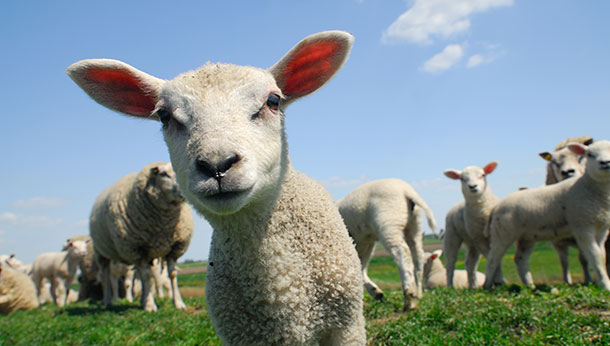
Costing the UK sheep industry up to £2 million a year, abortion in sheep is common. But, it shouldn’t be seen as an inevitable part of the reproductive cycle for your flock.
An abortion rate of 2% is considered to be normal but, if it rises above that there is an issue with your flock that warrants further investigation.
Lambing Percentage
Lambing percentage is a major factor in your profit margins and, even a small improvement can bring dividends. Just a 5% increase could mean an increase in net profits of 70%.
Many lost lambs are due to infectious diseases causing abortion, stillbirth and weak lambs. This is good news though as these can be controlled using practical and cost effective solutions.
The Most Common Diseases
The two most prevalent diseases, accounting for over 75% of abortions diagnosed in labs nationwide, are Enzootic Abortion (EAE) and Toxoplasmosis.
Recent surveys showed that a third of flocks tested have antibodies to both diseases. This indicates exposure of those ewes to the diseases. 4 out of 5 tested had antibodies to either EAE or Toxoplasmosis.
What is EAE and How to Control It
This disease is caused by the bacteria Chlamydia abortus. It is highly infectious and zoonotic. The organism directly damages the placenta resulting in abortion or the birth of weakly lambs. Vaginal discharge, dead lambs and placentas from ewes that are infected are heavily contaminated and can spread the infection to other ewes in the flock. Abortion does not usually occur at that point but in her subsequent pregnancy.
After aborting, the ewe may go on to have normal lambings but will be shedding the EAE organisms and will be a carrier of the disease.
The flock is usually exposed by new sheep being brought in. Wildlife and scavengers can also bring the disease to your farm from other infected flocks by carrying infected placentae from farm to farm.
The big issue with this disease is its latency. When a ewe aborts she sheds huge numbers of EAE organisms, infecting any ewe or lamb that comes into contact with them. These infected sheep show no signs of disease.
Due to the highly contagious nature of this disease considerable care must be taken when handling sheep during and after lambing. It is also incredibly important to note that this can be passed to humans and can cause abortion in pregnant women.
Careful disposal of dead lambs, placentae and contaminated material like bedding is imperative. You should also clean and disinfect the lambing pens and isolate the infected ewe from the rest of the flock until the vaginal discharge has cleared – normally six weeks.
We will be able to advise you on investigations including blood sampling ewes or post mortem examination of aborted lambs and placenta. Control measures including sourcing replacements form clean flocks and vaccination to protect your flock should be put in place to protect the flock going forward.
What is Toxoplasmosis and How to Control It
This is a microscopic parasite called Toxoplasma gondii and the source of the eggs is, most commonly, cat faeces in feed stores, bedding and manure. A single cat dropping can contain enough eggs to infect more than 100 ewes.
The eggs are ingested in water, feed, on pasture or in forage. They can survive for over a year in the environment but this disease isn’t normally passed from sheep to sheep.
Pregnant women can also suffer from this disease with serious implications so should not be allowed near the flock during and after lambing season.
Ewes in the early stages of pregnancy can suffer with foetal absorption and appear to be barren if infected. Barren rates can be as high as 8-10% of the flock. Infection between day 50 and 120 can result in premature birth and still born or weak lambs. Sometimes, mummified foetuses will be born. However, sheep infected when they’re not pregnant develop immunity to the disease.
Unfortunately, it is not possible to protect your sheep from toxoplasmosis by keeping a closed flock. The only way to completely avoid it is to vaccinate your sheep. Give us a call to discuss the options available.
If you have young cats on your farm, make sure they are wormed regularly and try to keep your flock away from areas that they frequent. Cats become infected by eating small animals (normally mice) that are carrying the eggs. Once infected, the cat will excrete the eggs in their faeces but the cat will only be contagious for a few weeks. Unfortunately, the eggs can survive for over a year in the environment.
Other Diseases to Watch For
Campylobacteriosis
- Caused by Campylobacter bacteria
- Spread by carrier sheep and wildlife
- No specific appearance to the aborted foetus
- Vaccination is important in the control of this disease
- Zoonotic potential
Salmonellosis
- Caused by the strains of the Salmonella bacteria
- Spread by infected stock and contaminated food
- No specific appearance for the aborted foetus but the ewes are often ill and have diarrhoea
- Antibiotics are effective. Speak to us about the options available
Listerosis
- Caused by Listeria monocytogenes/ivanovii
- Spread by the bacteria being present in the soil and soil-contaminated silage
- No specific appearance to the aborted foetus
- Antibiotics are ineffective
If you experience two abortions over two days, it is important you speak to your vet so they can investigate the cause, helping you keep your flock and your bottom line healthy.